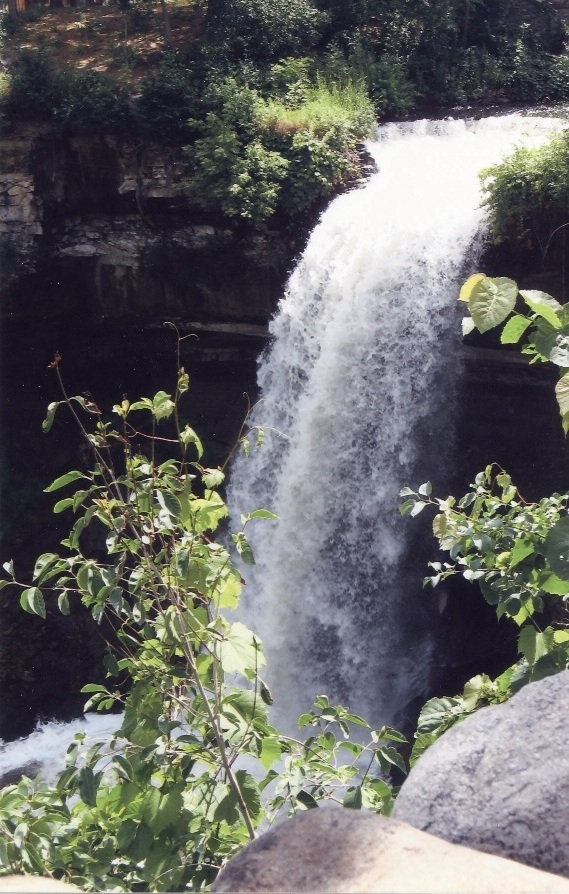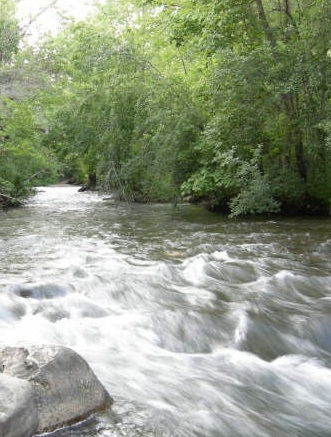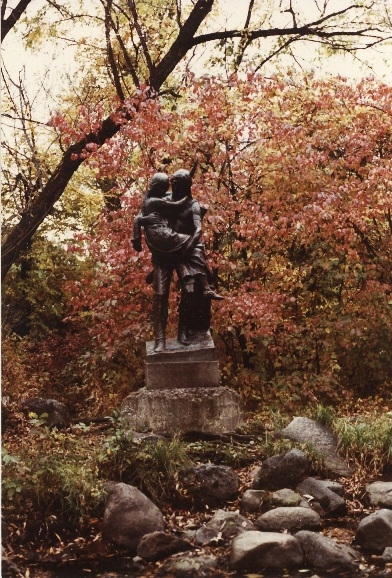
Minnehaha Falls
My friend Susan sent me a photograph of Minnehaha Falls, with the accompanying note, “How many other cities in the world have a true waterfall right in the heart of the city? The water in this tiny stream ends up in the Mississippi River before it gets to St. Paul, and then on down the middle of the USA to New Orleans and out into the big world er… I mean "water" . . . the Gulf of Mexico and then the Atlantic Ocean. Maybe the water from here will be waves against the shores of France!!”
Minnehaha Falls mean “laughing water”, as the Native Americans in the state of Minnesota had named it. The waterfall became famous after the grand epic poem “The Song of Hiawatha” by Henry Wadsworth Longfellow in 1855, featuring an Ojibwe warrior named Hiawatha. He was raised by his grandmother, Nokomis, on the shores of Lake Superior. The story was based on legends and ethnography of the Ojibwe and other Native American peoples. The central theme was the life and death of Hiawatha and his magical personality.
I was deeply moved by the poet’s portrayal of the Native American world, with endearing descriptions of forests and meadows, prairie and wildflowers, moonlight and starlight, ghosts and spirits, love and sorrow... The beauty of wilderness was familiar to me. Life in the woodlands had been a significant part of my childhood in Viet Nam, and I grew up with Vietnamese legends and folktales. I especially appreciated the secrets of nature and the wisdom of wild animals in “The Song of Hiawatha”. When my son Edward was little, sometimes I read part of the song to him at night, before his bedtime. The following excerpt was one of his favorites:
Sat the little Hiawatha;
Heard the whispering of the pine trees,
Heard the lapping of the water,
Sounds of music, words of wonder,
“Minne-wawa!” said the pine tree,
“Mudway-aushka” said the water.
Hiawatha married Minnehaha (laughing water), the Dakota maiden who was his true love. The young couple went on with their great adventures, and he became the ruler of the kingdom of Northwest Wind. At Minnehaha Park, there is an ironwood statue of Hiawatha carrying his bride Minnehaha across the creek. Longfellow had conveyed the charming devotion:
Over wide and rushing rivers,
In his arms he bore the maiden.
Minnehaha Park is very popular with summer visitors from around the world. There are hiking trails, picnic sites, and often entertainment like music and dance. The landscape is romantic and strikingly beautiful, and the park is a great location for cultural activities and weddings.
Susan and her husband, Gregg, used to canoe on Minnehaha Creek in the spring, after the melting of winter snow. The clear water flows all the way from Lake Minnetonka to the Mississippi River, but they would canoe it about half the distance, where they would get out and pull the canoe out of the creek, just before the water went over the falls.
One Sunday afternoon Susan was walking by the creek. Suddenly, she saw a family with two young children in a canoe going past the safety point. Knowing they were in danger, she shouted to the man in the canoe, "The falls are right ahead of you!" He didn’t hear and kept paddling forward. Luckily, some men heard her and they jumped into the water and helped pull the canoe out of the powerful current. The family, who was not Minnesota’s residents, felt most grateful.
In the early 80’s, I was working at the University of Minnesota’s community clinic. My colleague Jackie often talked about her Native American ancestors and shared with me her cultural heritage. She once told me, “ The city of Minneapolis means the city of Lakes. ” I also learned from Jackie the various types of homes, from dome-like wigwams to tent-like tepees, used in the woodlands and in the plains.
Donna was also Native American, who introduced me to deer meat, known as venison. And she taught me how to make crispy “frybread”, to be eaten with various toppings like ground meat, vegetables, and shredded cheese. One year, Jacki, Donna, and I decided to host a Native American and Southeast Asian feast at the clinic. The director was delighted and gave us time off to prepare for the feast. We cooked nearly the whole day and invited all the American staff to celebrate this special cross-cultural event.

Minnehaha Creek

Hiawatha and Minnehaha sculpture
